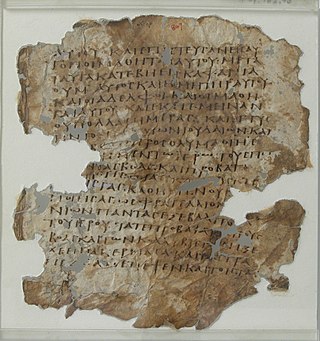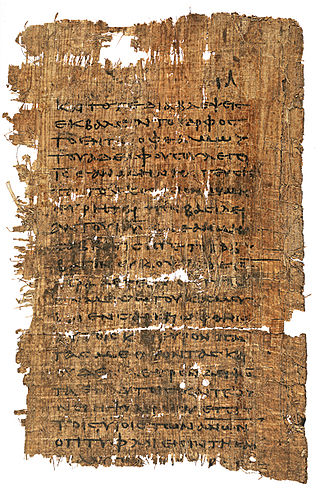
Uncial 0162, ε 023, is one vellum leaf of a Codex containing The Gospel of John in Greek. It has been paleographically assigned a 3rd or 4th century CE date.

The Oxyrhynchus Papyri are a group of manuscripts discovered during the late nineteenth and early twentieth centuries by papyrologists Bernard Pyne Grenfell and Arthur Surridge Hunt at an ancient rubbish dump near Oxyrhynchus in Egypt.

Papyrus Oxyrhynchus 405 is a fragment from a copy dating to c. 200 CE of the early Christian work Against Heresies, written by Irenaeus of Lyon around 180 CE.

Papyrus Oxyrhynchus 1 is a papyrus fragment of the logia of Jesus written in Greek. It was among the first of the Oxyrhynchus Papyri discovered by Grenfell and Hunt. It was discovered on the second day of excavation, 12 January 1897, in the garbage mounds in the Egyptian town of Oxyrhynchus. The fragment is dated to the early half of the 3rd century. Grenfell and Hunt originally dated the fragment between 150 and 300, but "probably not written much later than the year 200." It was later discovered to be the oldest manuscript of the Gospel of Thomas.

Papyrus Oxyrhynchus 23 is a fragment of the ninth book of Plato's Laws, written in Greek. It was discovered by Grenfell and Hunt in 1897 in Oxyrhynchus. The fragment is dated to the third century. It is housed in the Cambridge University Library. The text was published by Grenfell and Hunt in 1898.
Papyrus Oxyrhynchus 53 is a report on a persea tree, written in Greek. The manuscript was written on papyrus in the form of a sheet. It was discovered by Grenfell and Hunt in 1897 in Oxyrhynchus. The document was written on 25 February 316. It is housed in the British Museum. The text was published by Grenfell and Hunt in 1898.
Papyrus Oxyrhynchus 74 is a registration of property (ἀπογραφή) like P. Oxy. 72 and P. Oxy. 73. It is concerned with the registration of sheep and goats, and is written in Greek. The manuscript was written on papyrus in the form of a sheet. It was discovered by Grenfell and Hunt in 1897 in Oxyrhynchus. The document was written on 28 January 116. Currently it is housed in the library of the Hamilton College in Clinton. The text was published by Grenfell and Hunt in 1898.
Papyrus Oxyrhynchus 654 is a papyrus fragment of the logia of Jesus written in Greek. It is one of the Oxyrhynchus Papyri discovered by Grenfell and Hunt between 1897 and 1904 in the Egyptian town of Oxyrhynchus. The fragment is dated to the middle or late of the 3rd century. It is one of only three Greek manuscripts of the Gospel of Thomas.

Nag Hammadi Codex II is a papyrus codex with a collection of early Christian Gnostic texts in Coptic. The manuscript has survived in nearly perfect condition. The codex is dated to the 4th century. It is the only complete manuscript from antiquity with the text of the Gospel of Thomas.
Papyrus Oxyrhynchus 210 is an early Christian fragment, written in Greek. It was discovered in Oxyrhynchus. The manuscript was written on papyrus in the form of a codex. It is dated to the third century. Currently it is housed in the Cambridge University Library (4048) in Cambridge.
Papyrus Oxyrhynchus 146 is a receipt, written in Greek and discovered in Oxyrhynchus. The manuscript was written on papyrus in the form of a sheet. The document was written on 15 November 555. Currently it is housed in the Egyptian Museum (10076) in Cairo.
Papyrus Oxyrhynchus 212 consists of three fragments of a comedy of Aristophanes, written in Greek. It was discovered in Oxyrhynchus. The manuscript was written on papyrus in the form of a roll. It is dated to the first or second century. Currently it is housed in the British Library in London.
Papyrus Oxyrhynchus 223 is a fragment of Homer's Iliad (E,329-705), written in Greek. It was discovered in Oxyrhynchus. The manuscript was written on papyrus in the form of a roll. It is dated to the third century. Currently it is housed in the Bodleian Library in Oxford.
Papyrus Oxyrhynchus 236 consists of three fragments concerning Ptolemy Neos Dionysus (Auletes), written in Greek. They were discovered in Oxyrhynchus. The manuscript was written on papyrus in the form of a sheet. It is dated to the 1st century BC. Currently it is housed in The British Library.
Papyrus Oxyrhynchus 265 is a fragment of a Marriage Contract, in Greek. It was discovered in Oxyrhynchus. The manuscript was written on papyrus in the form of a sheet. It is dated to 81-96. Currently it is housed in the Thomas Fisher Rare Book Library of the University of Toronto in Toronto.
Papyrus Oxyrhynchus 267 is a fragment of an Agreement of Marriage in Greek. It was discovered in Oxyrhynchus. The manuscript was written on papyrus in the form of a sheet. It is dated to 22 May 37. Currently it is housed in the Milton S. Eisenhower Library of the Johns Hopkins University in Baltimore.
Papyrus Oxyrhynchus 288 is a fragment of a Taxation Account, in Greek. It was discovered in Oxyrhynchus. The manuscript was written on papyrus in the form of a sheet. It was written after 22 July 25. Currently it is housed in the British Library in London.
Papyrus Oxyrhynchus 285 is a fragment of an Extortion by a Tax-Collector, in Greek. It was discovered in Oxyrhynchus. The manuscript was written on papyrus in the form of a sheet. It is dated to the year about 50. Currently it is housed in the British Library in London.
Papyrus Oxyrhynchus 292 is a fragment of a Letter of Recommendation, in Greek. It was discovered in Oxyrhynchus. The manuscript was written on papyrus in the form of a sheet. It was written about 25. Currently it is housed in the Cambridge University Library in Cambridge.
Papyrus Oxyrhynchus 237 consists of a fragment of Petition of Dionysia to the Praefect, written in Greek. They were discovered in Oxyrhynchus. The manuscript was written on papyrus in the form of a roll. It was written after 27 June 186. Currently it is housed in the Bodleian Library.






